Green Cleaning of 3D-Printed Polymeric Products by Micro-/Nano-Bubbles
Abstract
1. Introduction
2. Materials and Methods
2.1. Materials and Characterization
2.2. Cleaning Operations
2.3. Evaluation of Oil Removal Rate
3. Results and Discussion
3.1. Cleaning Rubber Products
3.1.1. Cleaning by Soaking
3.1.2. Cleaning with Stirring
3.2. Cleaning Plastic Products
3.2.1. Cleaning by Soaking
3.2.2. Cleaning with Stirring
4. Conclusions
Author Contributions
Funding
Data Availability Statement
Conflicts of Interest
References
- Shahrubudin, N.; Lee, T.C.; Ramlan, R. An Overview on 3D Printing Technology: Technological, Materials, and Applications. Procedia Manuf. 2019, 35, 1286–1296. [Google Scholar] [CrossRef]
- Choi, J.-W.; Kim, H.-C. 3D Printing Technologies—A Review. J. Korean Soc. Manuf. Process Eng. 2015, 14, 1–8. [Google Scholar]
- Skelley, N.W.; Smith, M.J.; Ma, R. Three-dimensional Printing Technology in Orthopaedics. J. Am. Acad. Orthop. Surg. 2019, 27, 918–925. [Google Scholar] [CrossRef]
- Smith, T.M.; Kantzos, C.A.; Zarkevich, N.A.; Harder, B.J.; Heczko, M.; Gradl, P.R.; Thompson, A.C.; Mills, M.J.; Gabb, T.P.; Lawson, J.W. A 3D printable alloy designed for extreme environments. Nature 2023, 617, 513–518. [Google Scholar] [CrossRef]
- Yao, J.; Zou, F.L.; Feng, J.; You, R.T.; Sun, J.X.; Zhang, X.F.; Xiang, Y.Z. 3D printing technology based on nanometer materials in mechanical automation processing. Ferroelectrics 2021, 578, 81–94. [Google Scholar] [CrossRef]
- Wu, S.; Zeng, T.; Liu, Z.; Ma, G.; Xiong, Z.; Zuo, L.; Zhou, Z. 3D Printing Technology for Smart Clothing: A Topic Review. Materials 2022, 15, 7391. [Google Scholar] [CrossRef]
- Yang, S.; Du, P. The Application of 3D Printing Technology in Furniture Design. Sci. Program. 2022, 2022, 1960038. [Google Scholar] [CrossRef]
- Zhang, N.; Li, Y.B.; He, H.R.; Zhang, J.F.; Ma, G.S. You are what you eat: Microplastics in the feces of young men living in Beijing. Sci. Total Environ. 2021, 767, 144345. [Google Scholar] [CrossRef]
- Yan, Z.; Liu, Y.; Zhang, T.; Zhang, F.; Ren, H.; Zhang, Y. Analysis of Microplastics in Human Feces Reveals a Correlation between Fecal Microplastics and Inflammatory Bowel Disease Status. Environ. Sci. Technol. 2022, 56, 414–421. [Google Scholar] [CrossRef]
- Leslie, H.A.; van Velzen, M.J.M.; Brandsma, S.H.; Vethaak, A.D.; Garcia-Vallejo, J.J.; Lamoree, M.H. Discovery and quantification of plastic particle pollution in human blood. Environ. Int. 2022, 163, 107199. [Google Scholar] [CrossRef]
- Ragusa, A.; Svelato, A.; Santacroce, C.; Catalano, P.; Notarstefano, V.; Carnevali, O.; Papa, F.; Rongioletti, M.C.A.; Baiocco, F.; Draghi, S.; et al. Plasticenta: First evidence of microplastics in human placenta. Environ. Int. 2021, 146, 106274. [Google Scholar] [CrossRef]
- Ragusa, A.; Notarstefano, V.; Svelato, A.; Belloni, A.; Gioacchini, G.; Blondeel, C.; Zucchelli, E.; De Luca, C.; D’Avino, S.; Gulotta, A.; et al. Raman Microspectroscopy Detection and Characterisation of Microplastics in Human Breastmilk. Polymers 2022, 14, 2700. [Google Scholar] [CrossRef]
- Zhou, L.; Li, Z.J. Exploring the standard system of micro bubble technology. Water Purif. Technol. 2021, 40, 75–87. [Google Scholar]
- Zhang, L.; Chen, H.; Li, Z.; Fang, H.; Hu, J. Long lifetime of nanobubbles due to high inner density. Sci. China Ser. G-Phys. Mech. Astron. 2008, 51, 219–224. [Google Scholar] [CrossRef]
- Sun, L.; Zhang, F.; Guo, X.; Qiao, Z.; Zhu, Y.; Jin, N.; Cui, Y.; Yang, W. Research progress on bulk nanobubbles. Particuology 2022, 60, 99–106. [Google Scholar] [CrossRef]
- Nakashima, T.; Kobayashi, Y.; Hirata, Y. Method to exterminate blue-green algae in a large pond and to improve plant growth by micro-nanomicro-/nano- bubbles in activated water. Acta Hortic. 2012, 938, 391–400. [Google Scholar] [CrossRef]
- Zhou, Y.; Bastida, F.; Zhou, B.; Sun, Y.; Gu, T.; Li, S.; Li, Y. Soil fertility and crop production are fostered by micro-nanomicro-/nano- bubble irrigation with associated changes in soil bacterial community. Soil Biol. Biochem. 2020, 141, 107663. [Google Scholar] [CrossRef]
- Huang, Q.; Liu, A.; Zhang, L. Characteristics of micro and nano bubbles and their application in soil environment improvement. J. Environ. Eng. Technol. 2022, 12, 1324–1332. [Google Scholar]
- Agarwal, A.; Ng, W.J.; Liu, Y. Principle and applications of microbubble and nanobubble technology for water treatment. Chemosphere 2011, 84, 1175–1180. [Google Scholar] [CrossRef]
- Qian, X.; Wang, Y.; Xu, Y.; Ma, L.; Xue, N.; Jiang, Z.; Cao, Y.; Akakuru, O.U.; Li, J.; Zhang, S.; et al. Active targeting nano-scale bubbles enhanced ultrasound cavitation chemotherapy in Y-1 receptor-overexpressed breast cancer. J. Mater. Chem. B 2020, 8, 6837–6844. [Google Scholar] [CrossRef]
- Cai, W.B.; Yang, H.L.; Zhang, J.; Yin, J.K.; Yang, Y.L.; Yuan, L.J.; Zhang, L.; Duan, Y.Y. The Optimized Fabrication of Nanobubbles as Ultrasound Contrast Agents for Tumor Imaging. Sci. Rep. 2015, 5, 13725. [Google Scholar] [CrossRef]
- Huang, H.; Zhang, L.C.; Yang, Q.F. A Study on the Cleaning of Micro and Nano Bubbles in Porcelain Chips Unearthed from the Qinglong Town Site in Shanghai. Cult. Relics Prot. Archaeol. Sci. 2020, 32, 59–69. [Google Scholar]
- Zhang, H.J.; Xue, X.L.; Wu, N.; Yang, W.H.; Li, Z.J.; Ren, Q.; Zhao, Y.G. Application of micro-/nano- ozone bubble water for fruit and vegetable washing. Rural Sci. Technol. 2017, 388, 54–56. [Google Scholar]
- Klintham, P.; Tongchitpakdee, S.; Chinsirikul, W.; Mahakarnchanakul, W. Two-step washing with commercial vegetable washing solutions, and electrolyzed oxidizing microbubbles water to decontaminate sweet basil and Thai mint: A case study. Food Control 2018, 94, 324–330. [Google Scholar] [CrossRef]
- Lim, M.W.; Lau, E.V.; Poh, P.E. Micro-macrobubbles interactions and its application in flotation technology for the recovery of high density oil from contaminated sands. J. Pet. Sci. Eng. 2018, 161, 29–37. [Google Scholar] [CrossRef]
- Harun, M.H.C.; Zimmerman, W.B. Membrane defouling using microbubbles generated by fluidic oscillation. Water Supply 2019, 19, 97–106. [Google Scholar] [CrossRef]
- Ishizaki, T.; Matsuda, Y.; Morita, T.; Nishiuchi, Y.; Tada, K.; Nagahara, J.; Hata, T. Cleaning Effect by Fine Bubbles Generated with Gas-Liquid Share Method. J. Chem. Eng. Jpn. 2018, 51, 170–174. [Google Scholar] [CrossRef]
- Liao, Z.H.; Li, P. Research progress of micro nano bubble technology in the field of cleaning. Chem. Manag. 2020, 1, 98–100. [Google Scholar]
- Li, P.; Wang, J.; Liao, Z.; Ueda, Y.; Yoshikawa, K.; Zhang, G. Microbubbles for Effective Cleaning of Metal Surfaces Without Chemical Agents. Langmuir 2022, 38, 769–776. [Google Scholar] [CrossRef]
- Khuntia, S.; Majumder, S.K.; Ghosh, P. Microbubble-aided water and wastewater purification: A review. Rev. Chem. Eng. 2012, 28, 191–221. [Google Scholar] [CrossRef]
- Zhou, Y.; Cao, D.; Zhang, X. Degradation Mechanism of Micro-NanoMicro-/nano-bubble Technology for Organic Pollutants in Aqueous Solutions. Nanomaterials 2022, 12, 2654. [Google Scholar] [CrossRef]
- Yu, Z.; Li, J.; Zhang, X. A new hypothesis for cavitation nucleation in gas saturated solutions: Clustering of gas molecules lowers significantly the surface tension. Chin. J. Chem. Eng. 2022, 50, 347. [Google Scholar] [CrossRef]
- Lohse, D.; Zhang, X. Pinning and gas oversaturation imply stable single surface nanobubbles. Phys. Rev. E 2015, 91, 031003. [Google Scholar] [CrossRef]
- Ma, X.-t.; Li, M.-b.; Sun, C. Measurement and characterization of bulk nanobubbles by nanoparticle tracking analysis method. J. Hydrodyn. 2022, 34, 1121–1133. [Google Scholar] [CrossRef]
- Zhang, R.; Gao, Y.; Chen, L.; Ge, G. Nanobubble boundary layer thickness quantified by solvent relaxation NMR. J. Colloid Interface Sci. 2022, 609, 637–644. [Google Scholar] [CrossRef]

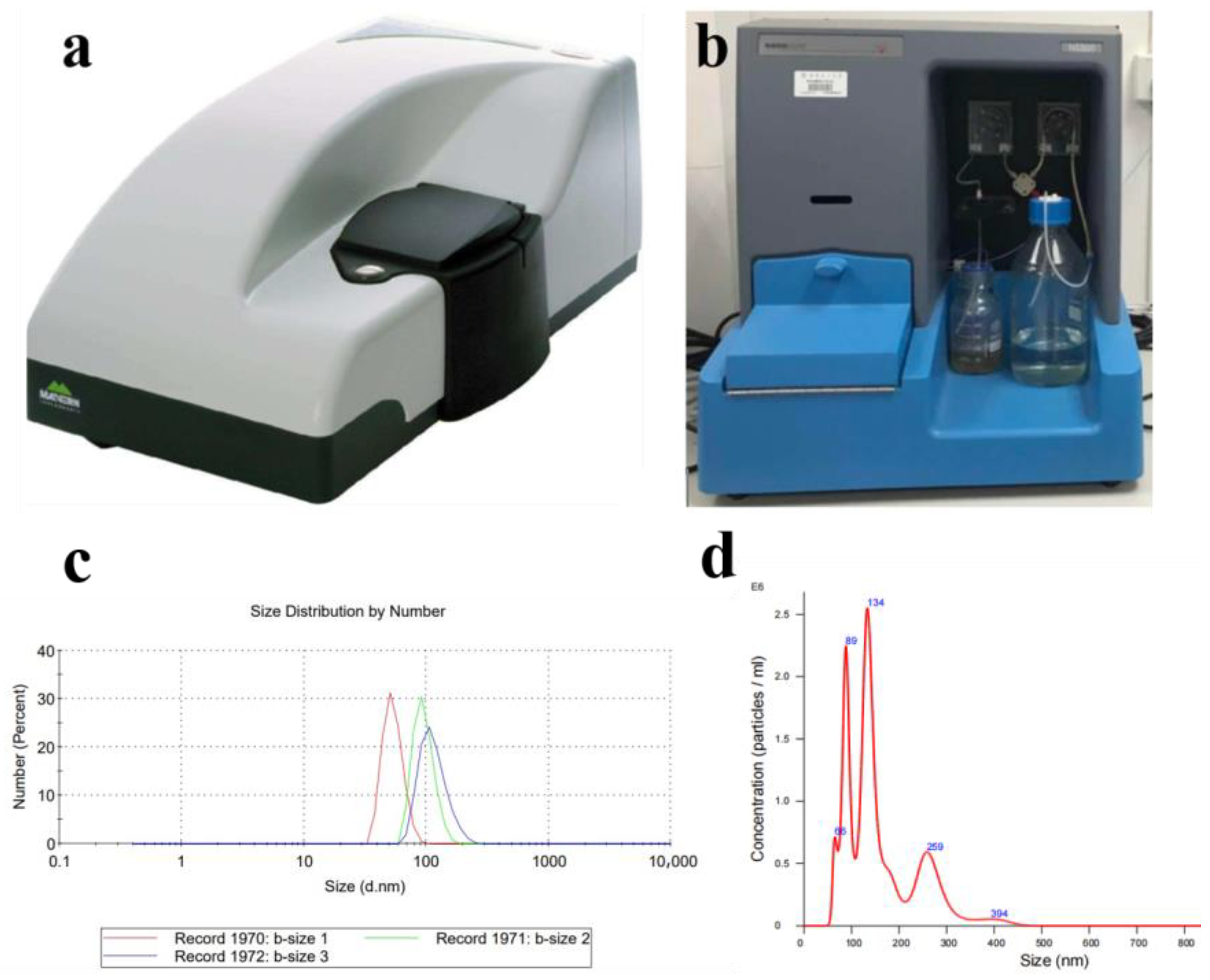
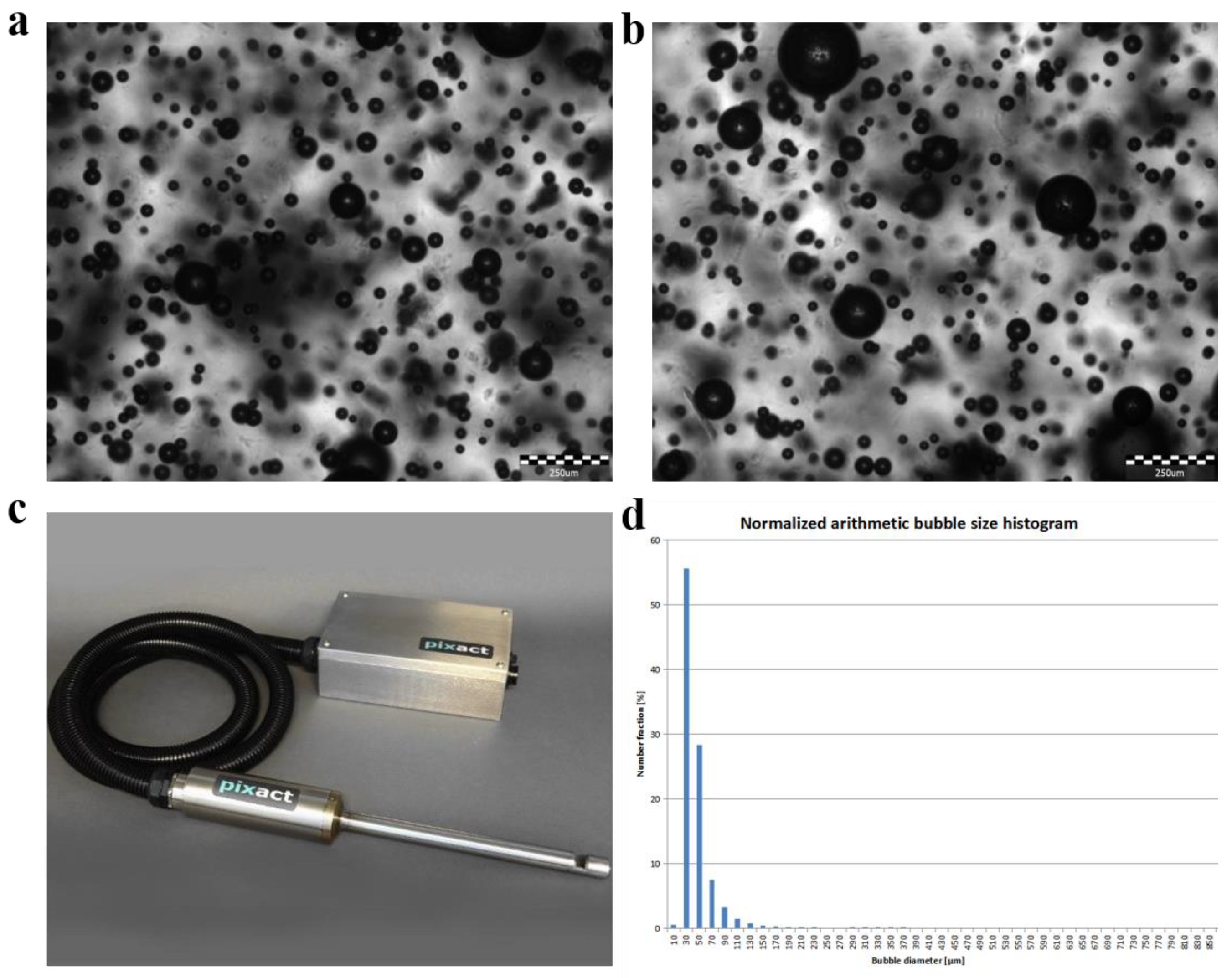

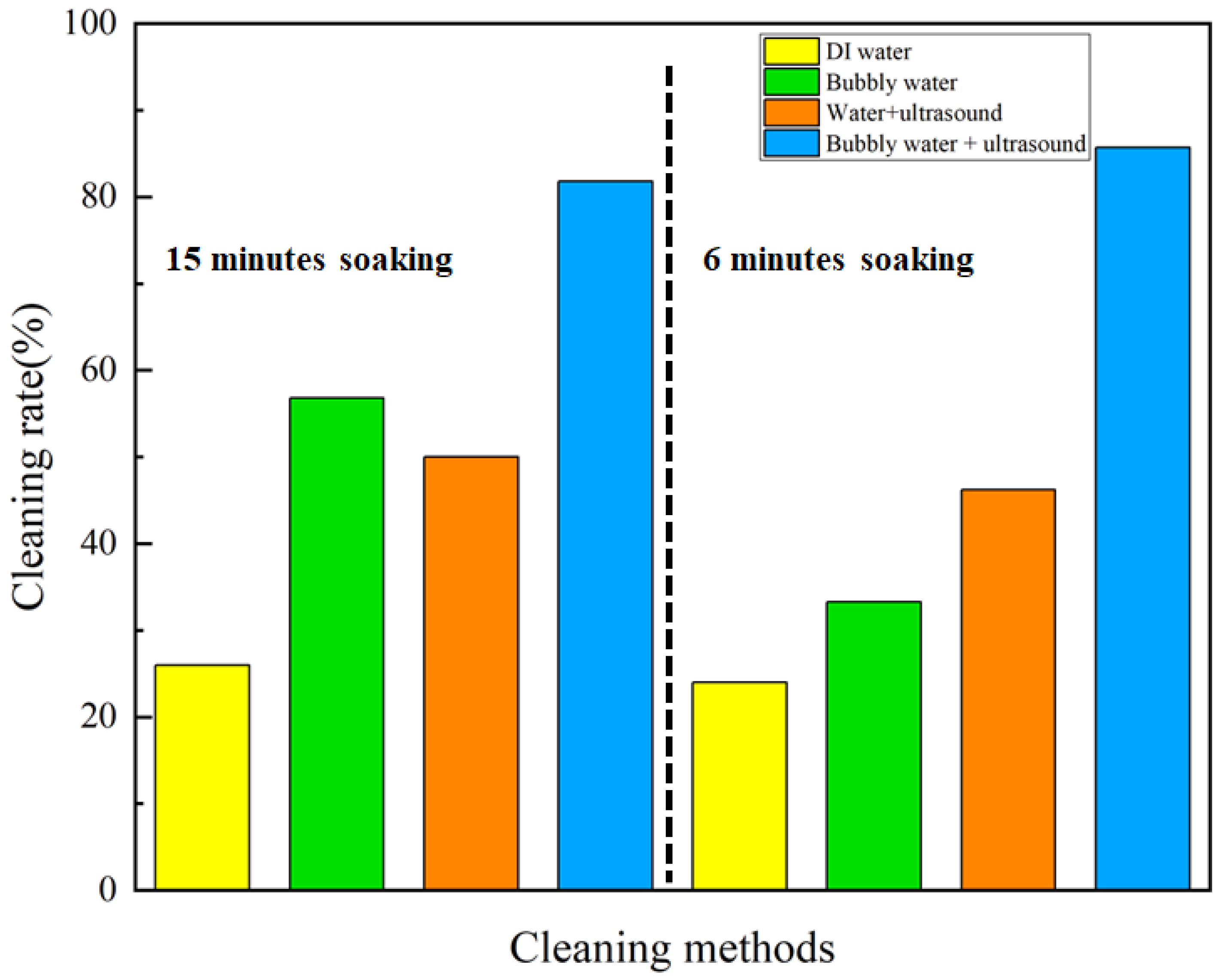
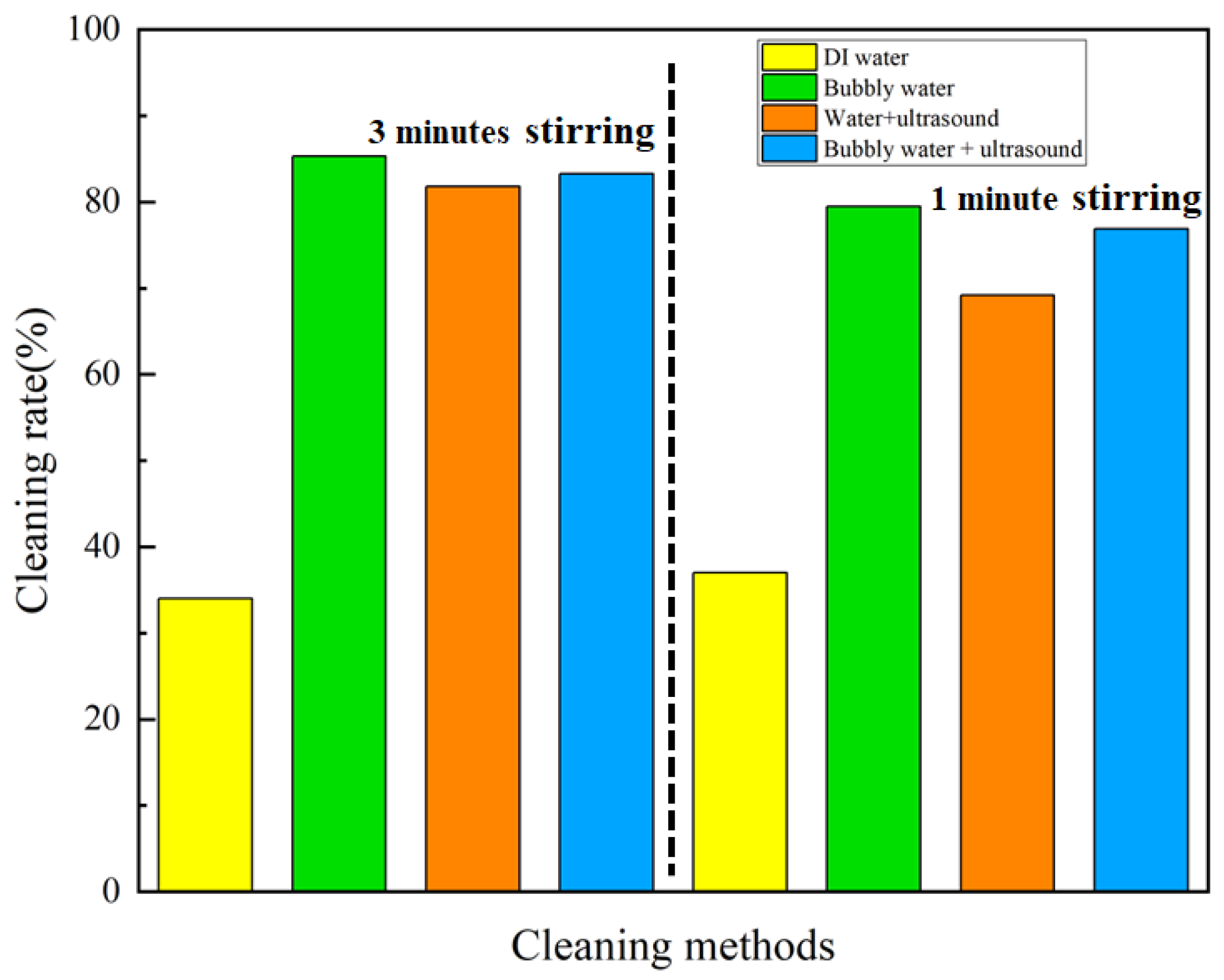
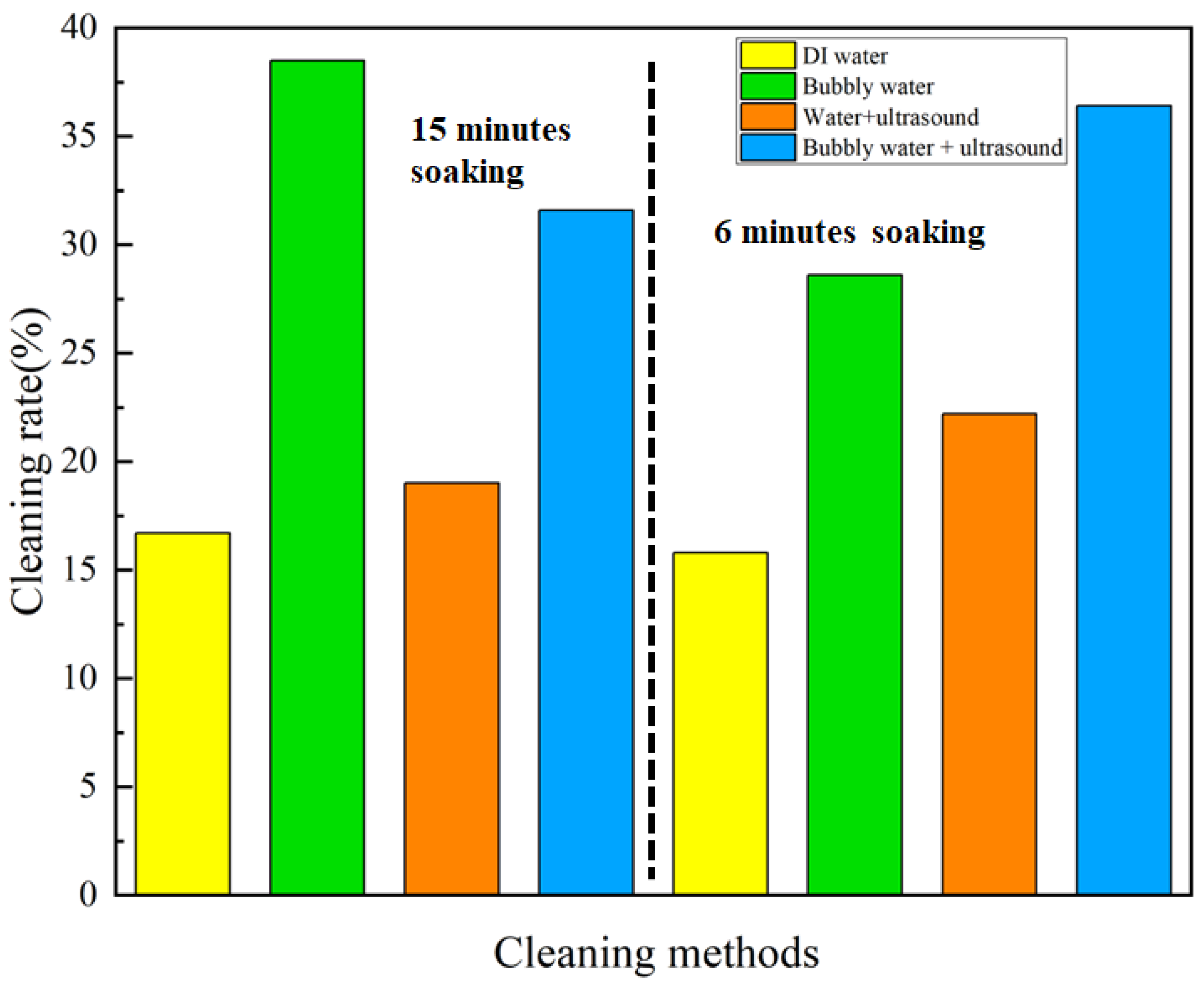
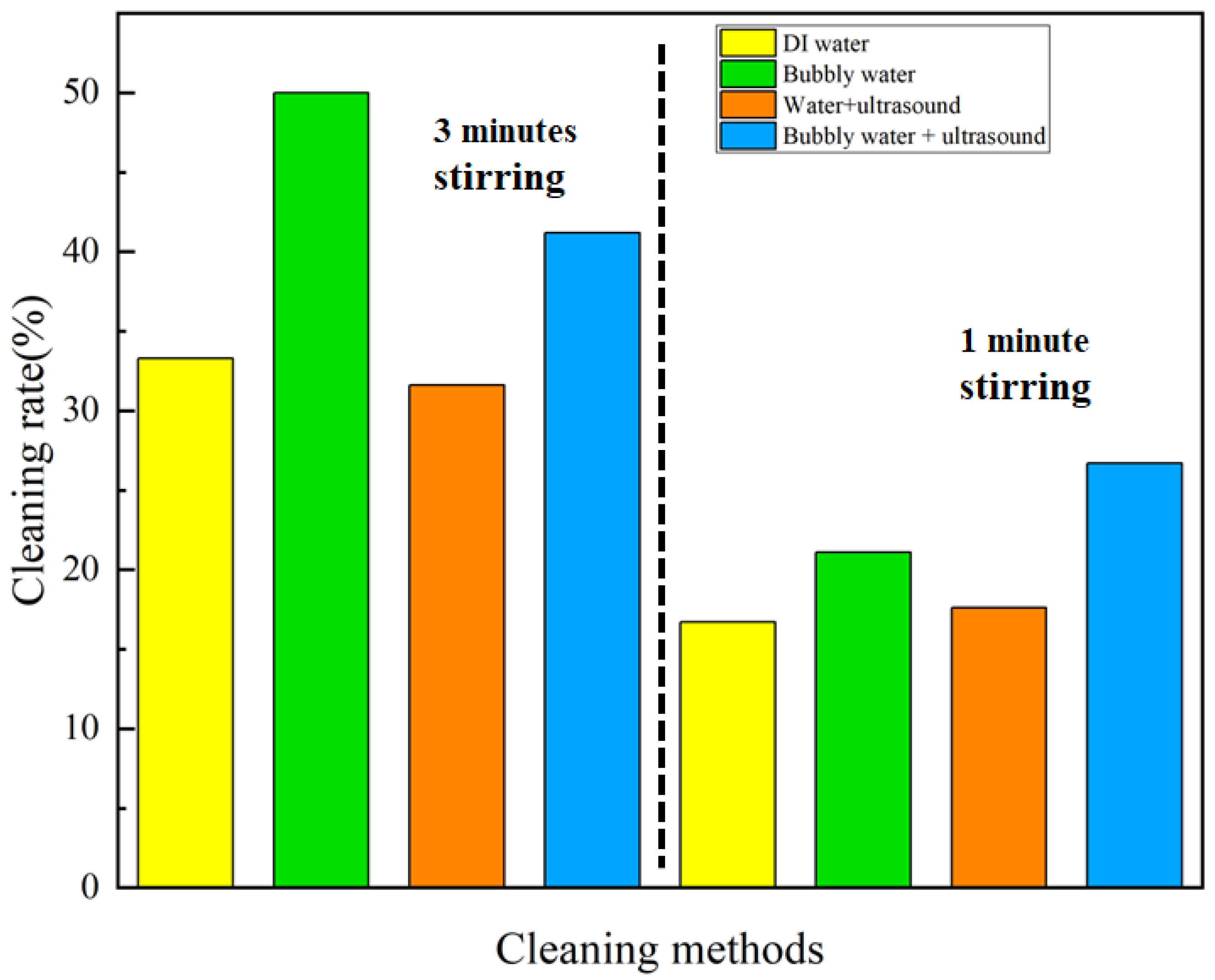
| Net Weight (g) | Weight with Oil (g) | Weight after Cleaning (g) | Weight of Oil Carried (g) | Weight of Oil Removed (g) | Removal Rate of Oil (%) | |
|---|---|---|---|---|---|---|
| Water | 4.31 | 4.81 | 4.68 | 0.50 | 0.13 | 26.0 |
| Bubbly water | 4.31 | 5.49 | 4.82 | 1.18 | 0.67 | 56.8 |
| Water + ultrasound | 4.16 | 4.40 | 4.28 | 0.24 | 0.12 | 50.0 |
| Bubbly water + ultrasound | 4.00 | 4.22 | 4.04 | 0.22 | 0.18 | 81.8 |
| Net Weight (g) | Weight with Oil (g) | Weight after Cleaning (g) | Weight of Oil Carried (g) | Weight of Oil Removed (g) | Removal Rate of Oil (%) | |
|---|---|---|---|---|---|---|
| Water | 4.25 | 4.75 | 4.63 | 0.5 | 0.12 | 24.0 |
| Bubbly water | 4.39 | 4.69 | 4.59 | 0.30 | 0.10 | 33.3 |
| Water + ultrasound | 4.16 | 4.42 | 4.30 | 0.26 | 0.12 | 46.2 |
| Bubbly water + ultrasound | 4.00 | 4.28 | 4.04 | 0.28 | 0.24 | 85.7 |
| Net Weight (g) | Weight with Oil (g) | Weight after Cleaning (g) | Weight of Oil Carried (g) | Weight of Oil Removed (g) | Removal Rate of Oil (%) | |
|---|---|---|---|---|---|---|
| Water | 4.35 | 4.88 | 4.70 | 0.53 | 0.18 | 34.0 |
| Bubbly water | 4.52 | 4.86 | 4.57 | 0.34 | 0.29 | 85.3 |
| Water + ultrasound | 4.30 | 4.52 | 4.34 | 0.22 | 0.18 | 81.8 |
| Bubbly water + ultrasound | 4.30 | 4.54 | 4.34 | 0.24 | 0.20 | 83.3 |
| Net Weight (g) | Weight with Oil (g) | Weight after Cleaning (g) | Weight of Oil Carried (g) | Weight of Oil Removed (g) | Removal Rate of Oil (%) | |
|---|---|---|---|---|---|---|
| Water | 4.17 | 4.63 | 4.46 | 0.46 | 0.17 | 37.0 |
| Bubbly water | 4.36 | 4.75 | 4.44 | 0.39 | 0.31 | 79.5 |
| Water + ultrasound | 4.30 | 4.56 | 4.38 | 0.26 | 0.18 | 69.2 |
| Bubbly water + ultrasound | 4.36 | 4.62 | 4.42 | 0.26 | 0.20 | 76.9 |
| Net Weight (g) | Weight with Oil (g) | Weight after Cleaning (g) | Weight of Oil Carried (g) | Weight of Oil Removed (g) | Removal Rate of Oil (%) | |
|---|---|---|---|---|---|---|
| Water | 0.41 | 0.59 | 0.56 | 0.18 | 0.03 | 16.7 |
| Bubbly water | 0.41 | 0.67 | 0.57 | 0.26 | 0.10 | 38.5 |
| Water + ultrasound | 0.39 | 0.60 | 0.56 | 0.21 | 0.04 | 19.0 |
| Bubbly water + ultrasound | 0.44 | 0.63 | 0.57 | 0.19 | 0.06 | 31.6 |
| Net Weight (g) | Weight with Oil (g) | Weight after Cleaning (g) | Weight of Oil Carried (g) | Weight of Oil Removed (g) | Removal Rate of Oil (%) | |
|---|---|---|---|---|---|---|
| Water | 0.46 | 0.65 | 0.62 | 0.19 | 0.03 | 15.8 |
| Bubbly water | 0.43 | 0.64 | 0.58 | 0.21 | 0.06 | 28.6 |
| Water + ultrasound | 0.51 | 0.69 | 0.65 | 0.18 | 0.04 | 22.2 |
| Bubbly water + ultrasound | 0.40 | 0.62 | 0.54 | 0.22 | 0.08 | 36.4 |
| Net Weight (g) | Weight with Oil (g) | Weight after Cleaning (g) | Weight of Oil Carried (g) | Weight of Oil Removed (g) | Removal Rate of Oil (%) | |
|---|---|---|---|---|---|---|
| Water | 0.50 | 0.65 | 0.60 | 0.15 | 0.05 | 33.3 |
| Bubbly water | 0.53 | 0.69 | 0.61 | 0.16 | 0.08 | 50.0 |
| Water + ultrasound | 0.40 | 0.59 | 0.53 | 0.19 | 0.06 | 31.6 |
| Bubbly water + ultrasound | 0.42 | 0.66 | 0.56 | 0.24 | 0.10 | 41.2 |
| Net Weight (g) | Weight with Oil (g) | Weight after Cleaning (g) | Weight of Oil Carried (g) | Weight of Oil Removed (g) | Removal Rate of Oil (%) | |
|---|---|---|---|---|---|---|
| Water | 0.44 | 0.62 | 0.59 | 0.18 | 0.03 | 16.7 |
| Bubbly water | 0.40 | 0.59 | 0.55 | 0.19 | 0.04 | 21.1 |
| Water + ultrasound | 0.51 | 0.68 | 0.65 | 0.17 | 0.03 | 17.6 |
| Bubbly water + ultrasound | 0.38 | 0.53 | 0.49 | 0.15 | 0.04 | 26.7 |
Disclaimer/Publisher’s Note: The statements, opinions and data contained in all publications are solely those of the individual author(s) and contributor(s) and not of MDPI and/or the editor(s). MDPI and/or the editor(s) disclaim responsibility for any injury to people or property resulting from any ideas, methods, instructions or products referred to in the content. |
© 2023 by the authors. Licensee MDPI, Basel, Switzerland. This article is an open access article distributed under the terms and conditions of the Creative Commons Attribution (CC BY) license (https://creativecommons.org/licenses/by/4.0/).
Share and Cite
Gao, H.; Zhang, F.; Tang, K.; Luo, X.; Pu, Z.; Zhao, J.; Jiao, Z.; Yang, W. Green Cleaning of 3D-Printed Polymeric Products by Micro-/Nano-Bubbles. Nanomaterials 2023, 13, 1804. https://doi.org/10.3390/nano13111804
Gao H, Zhang F, Tang K, Luo X, Pu Z, Zhao J, Jiao Z, Yang W. Green Cleaning of 3D-Printed Polymeric Products by Micro-/Nano-Bubbles. Nanomaterials. 2023; 13(11):1804. https://doi.org/10.3390/nano13111804
Chicago/Turabian StyleGao, Haoxiang, Fenghua Zhang, Kangkang Tang, Xianyu Luo, Ziang Pu, Jiuzhou Zhao, Zhiwei Jiao, and Weimin Yang. 2023. "Green Cleaning of 3D-Printed Polymeric Products by Micro-/Nano-Bubbles" Nanomaterials 13, no. 11: 1804. https://doi.org/10.3390/nano13111804
APA StyleGao, H., Zhang, F., Tang, K., Luo, X., Pu, Z., Zhao, J., Jiao, Z., & Yang, W. (2023). Green Cleaning of 3D-Printed Polymeric Products by Micro-/Nano-Bubbles. Nanomaterials, 13(11), 1804. https://doi.org/10.3390/nano13111804






